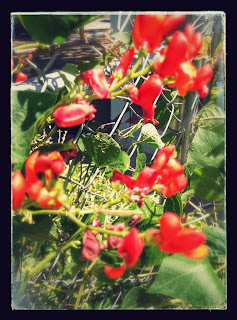When I re-read look at them beans this morning, I was astounded to see that I had bought four SRB plants as soon as we finished putting up the fence in 2009, and had saved the seed to plant the next year and, indeed, just about every year since. In other words, all the SRBs I have grown here are descendants of four plants. I still love to see their blossoms appear on our side gate:
The huge pods, however, attract a thick powdery mildew that fills me with fear and loathing. The photo of the ungainly specimen below was taken after I had cut the vine at ground level so that the nearby leaves had totally shriveled:
The green leaves at the right belong to a much better variety of bean, the Worcester Indian Red Pole Lima (aka Peruvian Lima), grown from seed I had ordered on line from Amishland Seeds in 2012. According to Amishland's descriptive catalog, the Incas dried these beans and ground them into flour. I let them dry on the vine and then use them to make soup or stew along with other veggies, usually spiced with East Indian sambar masala. I enjoy the juxtaposition of a pre-Columbian New World bean with an Old World spice.
When I ordered bean seeds from Amishland Seeds, they were offering a promotion: one free variety with four. How could I resist? I don't remember which was the free one, but I was delighted when I received five packets of 10 seeds each in the mail: Peruvian Lima, Amish Gnuddel, Lazy Wife, Anellino, and Cascade Giant. Of course I should have planted them right away, but for some reason I waited till fall of 2014 and then chose the Peruvian Lima.
It was in fall 2014 that I first planted veggies following the principles of companion planting and crop rotation. Previously I had relied solely on aesthetic principles: if I had four boysenberry plants, I spaced them evenly along the fence. Same thing with tomato plants and bean or pea seeds. It didn't work very well, and so last fall I moved the boysenberry plants into the same section of of the bed. But beans are supposed to be good companions for any other veggie, and besides they 'fix' nitrogen. And so I started my saved SRB seeds and my new Peruvian Lima seeds indoors in toilet paper tubes and planted them evenly all along the fence in November or December. They soon started producing tiny white and yellow blossoms:

Of those saved for seed, some have become companions for chayotes, and some for gourds. Because the seed pods 'shatter' when mature, some have come up volunteer on both sides of the fence. I cannot imagine planting a garden without Peruvian Limas, though I've learned that boysenberries dislike pole beans. I took out all the pole beans from the berry patch and I think the problem was competition for space on the fence. Anyway the boysenberries are looking happier, even with tomatoes encroaching a bit.
What of the other four Amishland bean varieties? Due to my having aged them so long, the germination was spotty at best. I currently have ONE Amish Gnuddel plant, THREE Lazy Wife plants, and THREE that may be either Cascade Giants or Anellinos. A report on their progress, if any, must wait until another day.



5 comments:
Where did you get them seeds?
Robert is going to plant some beans...Thanks for the info!
Kathy,
There's a link to Amishland Seeds in the posting, but here it is again: http://www.amishlandseeds.com/ . There's a lot of reading matter there.
Caroline tried to grow some beans ----but she (and we) like tomatoes better. Also, there are leafy veggies that she can grow.
Since we did a major remodel on the house (added three bedrooms, 2 baths, and small den), the garden area has been wiped out. The new garden area is smaller and a little more difficult to cultivate. But another year of roto tilling and mixing in some decent top-soil ought to do it.
Tomatoes ARE the best veggie, but beans have a much longer season. Here in SoCal we can plant them in the late fall and start harvesting in early spring. Good luck with building up your topsoil. New construction makes it hard, but is usually worth the effort in the long run.
Post a Comment